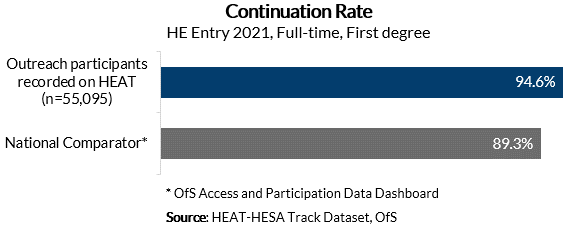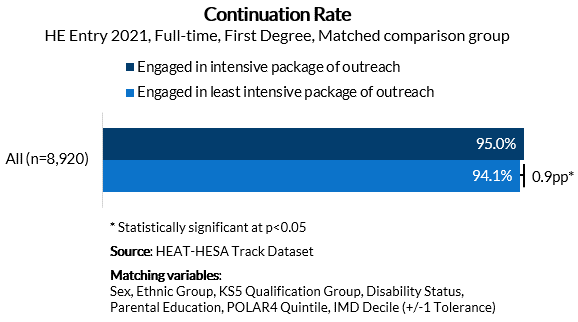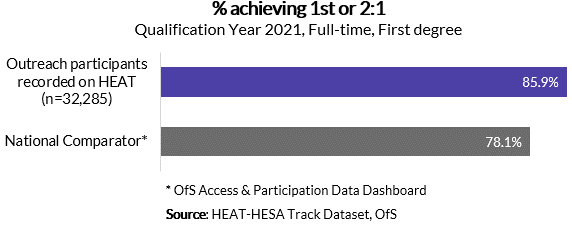1. Access
Of all outreach participants recorded on HEAT who were expected to enter HE in 2020, 57.7% were found in the HE population by 2021. At national level, only 46.8% of young people entered HE within two years of being expected to do so, according to the Department for Education’s (DfE) latest Widening Participation in Higher Education statistics (DfE, 2023) (Figure 1). The higher proportion of outreach participants entering HE suggests that being in receipt of outreach interventions may contribute towards students’ likelihood of accessing HE.
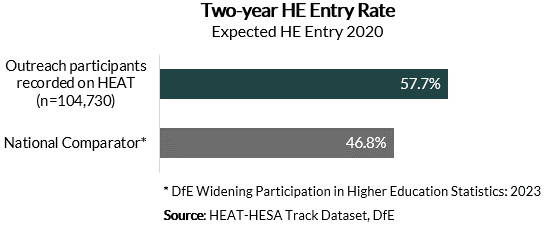
Figure 1: Two-year HE Entry Rate of outreach participants compared to the national average
To explore the impact of participation in outreach on HE progression further, we next apply a quasi-experimental matched cohort design to investigate if there are statistically significant differences in HE entry when comparing a group of students who participated in an intensive package of outreach to a closely matched group of students who participated in little or no outreach.
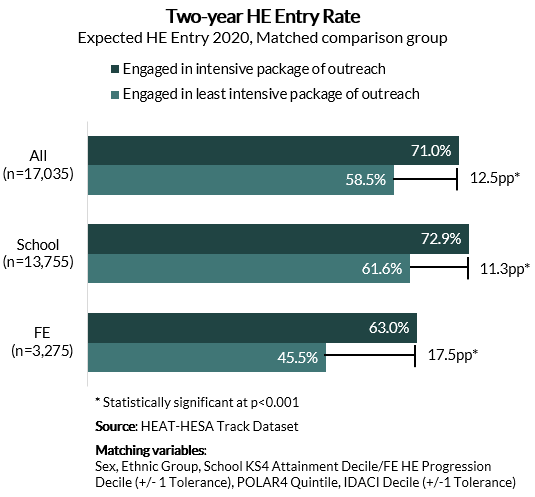
Figure 2: Two-year HE Entry Rates of closely matched groups of outreach participants
Across all outreach participants included in the matched analysis, those in receipt of an intensive package of outreach entered HE at a rate of 71%, compared to only 58.5% of those in receipt of little or no outreach (Figure 2). The percentage point gap of 12.5 was found to be statistically significant and those engaged in intensive outreach were thus 1.2 times more likely to progress to HE within two years of being expected to enter.
Therefore, after controlling for factors known to affect progression to HE, rates of HE entry remain higher for students who have engaged in an intensive package of outreach when compared with those who have not. This allows us to be more confident in stating that the differences we observe can be attributed to outreach participation, rather than occurring as a result of other differences between the two groups.
The majority of the matched sample consisted of students who participated in outreach while at a secondary school. Among this group a particularly high HE entry rate of 72.9% was observed. The gap to a matched comparator group of school students who received little to no outreach was 11.3 percentage points, which was found to be statistically significant. This suggests that school students who engage in an intensive package of outreach have an increased likelihood of entering HE.
A smaller subsection of the matched group consisted of students who participated in outreach while at a FE college5. Of those in receipt of an intensive package of outreach, 63% entered HE, compared to only 45.5% of those in receipt of little to no outreach. The large gap between entry rates of FE students who participated in an intensive package of outreach to those who did not was found to be statistically significant and those in receipt of an intensive package of outreach in this subgroup were therefore 1.4 times more likely to enter HE than their counterparts in receipt of little to no outreach. This gap suggests that FE students may particularly benefit from participation in an intensive package of outreach.
It should be noted that the proportion of FE learners in the matched cohort is smaller than the proportion of learners who only participated while in secondary school or sixth form. FE learners may have had less time and opportunity to participate in outreach, in particular if only participating while at a FE college, which means they may be less likely to meet the threshold for an intensive package of outreach resulting in a smaller sample size for this analysis.
Return to Introduction
 Students who took part in an intensive package of outreach consisting of at least eight contact hours are 12.5 percentage points more likely to enter higher education than a closely matched group of students who took part in less than three hours of outreach.*
Students who took part in an intensive package of outreach consisting of at least eight contact hours are 12.5 percentage points more likely to enter higher education than a closely matched group of students who took part in less than three hours of outreach.* In particular, further education students appear to benefit from participating in intensive outreach with those in receipt being more than 17 percentage points more likely to enter higher education than their peers in receipt of little to no outreach.
In particular, further education students appear to benefit from participating in intensive outreach with those in receipt being more than 17 percentage points more likely to enter higher education than their peers in receipt of little to no outreach. Once in higher education, outreach participants show similar continuation and degree attainment success rates to the national average.
Once in higher education, outreach participants show similar continuation and degree attainment success rates to the national average.


